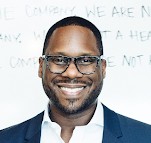How a Diverse Culture Drives Employee Engagement and Business Growth



It takes empathy to understand how to best meet your customers’ needs. That’s why cultivating an engaged team of employees with diverse cultural and experiential backgrounds is critical for business growth.

Omar Johnson
Over the course of the COVID-19 pandemic, we all came face to face with our own mortality and our fears for our country, our families, our friends and co-workers. Now, as leaders, we can encourage our team members to stop, breathe, and realize, “You know what? We are not finished with the pandemic, but the odds are in our favor to survive.” It’s time for everyone to work through that anxiety so they can get back to the things that matter in today’s hybrid work environment.
Unfortunately, this new remote workplace culture can cause a whole new set of worries for workers. Many of your team members are asking themselves, “What does success even mean now?” and “Where are my boundaries now that I’m on Zoom all day?” This can be especially tough for leaders who are used to sitting in meetings and being able to sense tension, confidence, fear and curiosity — the signals that govern how we lead.
The employee perspective can also be a challenge. I recently spoke to a senior leader who said, “Well the big meeting happened, and it was canceled off of my calendar, so I think I got uninvited,” to which I replied, “They could’ve just moved the Zoom.” But that wasn’t his first thought. Now, people start to measure their relevance by whether they’re on the invitation list for a video meeting. They’re reading into digital glitches and oversights and seeing them as slights.
These feelings of powerlessness and fear are amplified by the lack of a physical workplace. There’s no water cooler conversation, no shared lunch, no after-work drinks. We’re missing the connection and shared sense of culture created by these things, and we aren’t getting the corporate knowledge transfer that happens in those informal settings.
So, how do we help people process moving forward, and how do you give them tools to manage where we are and where we’re going? It all starts with building and nurturing a culture of diversity.
How diversity unlocks employee engagement and business growth
If you’re a business owner, chances are you want to grow your company. To successfully do so, you have to serve women, men, non-binary, Black, white, Asian, and Latinx people of all ages. This means you have to find ways to effectively connect with people in different ways. This is the business case for building a diverse workforce.
Building the business case for diversity and getting buy-in is essential for moving diversity from a nice-to-have side metric to a thriving reality. We’ve got to teach leaders throughout the organization that you can hit even higher numbers with more customer empathy. The more diverse inputs you have from your frontline teams, the better capable you will all be to drive stronger business results.
If it doesn’t get measured, it won’t get done
Making a concerted effort to build this diverse team, even when you agree that it will bring better results, can feel overwhelming. When tackling something hard, your human nature wants to be around like-minded people who understand your communication style and all of the nuances associated with you as an individual. That tends to be people who look like you. This dynamic is a direct contrast to the vulnerability, empathy, and inclusivity that it takes to build a diverse organization.
You might think you don’t have the time to focus on diversity in the high-speed, high-pressure era of modern business. But if we, as leaders, make sure everyone on the team is being held accountable, that’s when it works. That more diverse team you’re developing not only compounds your diversity hiring efforts as more people see themselves reflected in the business, it also ultimately impacts understanding of your customer base, which is the key to hitting your financial goals.
It’s not enough just to hold people accountable for creating a diverse workforce. It’s critical to commit to measuring both the diversity of your teams and how that diversity is driving business results. This is not an experiment where we can say that “we tried and failed,” because we cannot fail. This is the real world around us and the next generation doesn’t see diversity as a corporate construct: Gen Z sees it as real life.
Leaders need to walk their diversity talk, one conversation at a time
If your leadership team all looks the same, comes from the same backgrounds, and you all play golf or basketball together every weekend, you’re likely not leading by example. And it has to start at the top.
After the murder of George Floyd, I received over 50 calls from white executives nationwide asking, “What do I do?” and saying they wanted to be a part of the solution, but didn’t know how to get it right. If the executives in my network were reaching out, there must have been thousands more with the same questions. I wrote an open letter, “Dear White Corporate America,” that was as much a statement to my team about who we are as a company as it was about addressing specific issues. It was about showing that when we see something wrong, we are going to take action.
When you publicly commit to building a diverse culture that stands for something, you inspire other people to do it. Once you put action behind words in an authentic way, you’re better equipped to make diversity and inclusion a core value, and to encourage your employees to make diversity a priority. If you already have a positive, engaged culture, your actions are going to be more powerful than your guidelines.
Commit to diversity and unlock employee engagement
There’s a magical thing about making a commitment to diversity in the workplace: it makes creating an engaged workplace culture, and taking the actions I outlined above, a lot easier. It gives you the opportunity to engage with your team to learn from their insights and experiences. Once you’re vulnerable enough to say you don’t know, you’ll find people who are willing to point you in the right direction.
So, what’s your way forward? How can you build an inclusive team that uplifts voices and encourages innovation?
Small steps to take today for a more engaged workplace culture
Building an engaged, diverse, and inclusive culture isn’t a box to check on your to-do list; it is something you work toward every day. Here are four small steps you can take to make a big impact on your company culture and employee engagement:
Build team core values that celebrate authenticity
Corporate values don’t always translate into building a diverse culture. Create team values that help teams celebrate differences between individuals. For example, we encourage our team to speak with their native accents. It’s a simple gesture, but asking staff to be more of their whole selves brings more color into our calls and dialogs.
Map personal interests to tasks and development plans
Encourage your staff to pursue personal interests that align with the work your company does. You’ll be surprised at how a passion for grime music or trail riding can power great experiences at a team offsite.
Build collaborative spaces
How can you transform your physical office from individual workspaces to places that facilitate brainstorming and team collaboration?
Empower micro-moments
Give everyone on your team the authority and the budget to create what we call micro-moments with the people they work with. Examples can be inviting team members over for Shabbat, a curry chicken and roti lunch or bringing in a box full of Tim Tams from Australia.
The power of micro-moments to build an engaged culture
As we’ve adapted to our remote and hybrid teams, you find that people now go from Zoom to Zoom. Video calls bring teams together easily despite being geographically dispersed, but then we end up on these screens all day. We’re missing out on the unexpected relationship-building moments.
In my new venture as the founder of Opus United — a collective of creatives, data scientists, strategists, athletes, and musicians powering world-class brands — I am invested in the authorship of our culture. That’s why I asked my leadership team to come back to me with a budget and ideas for how to create micro-moments with their teams. It’s those chance conversations, those casual interactions that catalyze culture, learning, and curiosity — and ultimately, our discovery of the people on our team. That discovery is what allows us to create a positive company culture, built on that foundation of diversity and inclusion.
Only through creating and nurturing an engaged, diverse, and inclusive workforce will your business be able to come up with and implement world-changing, transformative ideas. It starts with making the commitment to put diversity into the business-critical category for yourself, and your organization.
Build your best customer service team
Uncover how to hire, train, and empower your customer service team with the best digital tools and training.


























